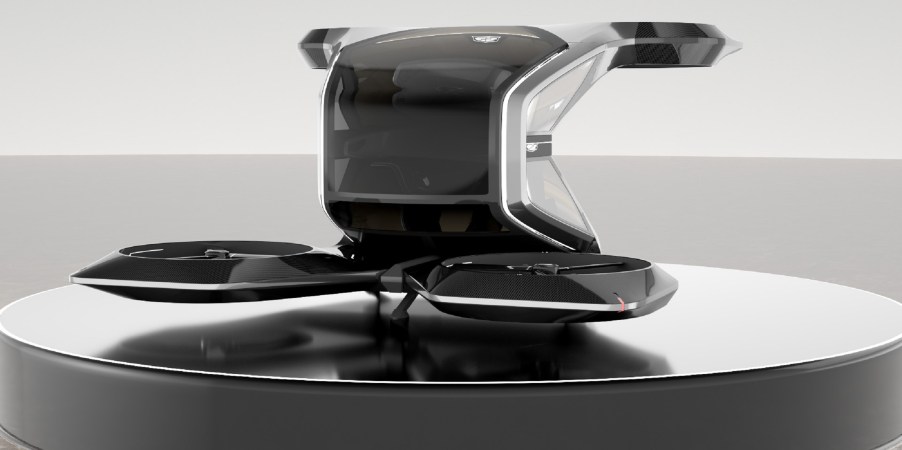
Cadillac’s New Concept Will Only Fly on a Wing and a Prayer
GM virtually showed off its upcoming vehicles and concept cars at this year’s CES. And sprinkled among the EVs were several new projects from Cadillac. Some were essentially autonomous pods, but there was one more thing. It’s the Cadillac eVTOL concept, and it’s a flying ‘car.’ But it won’t be getting off the ground anytime soon.
The Cadillac eVOTL flying car concept

Technically, the Cadillac eVOTL concept is less a flying car and more of an “efficient helicopter,” Autoweek reports. But this type of aircraft is “commonly known as a flying car or air taxi,” CNBC reports, so we’re going with it.
‘eVTOL’ stands for ‘electric vertical takeoff and landing,’ which is what the Cadillac eVTOL does. Unlike an airplane, the eVTOL doesn’t need a runway or airstrip to get into or out of the air. Instead, four rotors let it vertically ascend and descend, not unlike a helicopter.
As of this writing, concrete technical details are relatively scant on the Cadillac eVTOL concept. It appears to be a single-seater craft, Roadshow reports. And we know it powers the rotors via a 90-kW (about 121 hp) electric motor, giving a top speed of 56 mph. It also uses GM’s Ultium battery pack technology, Reuters reports, and is fully autonomous. At least, theoretically.
The ‘theoretically’ part is because the Cadillac eVTOL concept doesn’t physically exist. It’s meant to be a virtual design exercise, The Verge reports. And as of this writing, GM hasn’t confirmed if it’s planning an IRL production version. Though it’s worth pointing out, the automaker has previously expressed an interest in flying taxi development.
Cadillac isn’t the only automaker working on a flying car
While the Cadillac eVTOL concept may be virtual for now, several major automotive companies have already started pursuing flying cars.
Porsche, for example, has partnered with Boeing to develop a flying sports car. Hyundai also wants automobiles that can take to the skies. Even Uber has expressed an interest in flying taxis. And independent companies have been at it for some time, too.

In fact, Cadillac isn’t even the only automotive brand with a 2021 CES flying car announcement. FCA announced a partnership with California-based Archer Aviation to develop all-electric VTOL aircraft, Roadshow reports. The flying car will reportedly have a top speed of 150 mph and a range of 60 miles. But production isn’t expected to start until 2023.
That’s a common refrain amongst flying car projects. The hydrogen-powered CityHawk, for example, likely won’t be ready for sale until 2024. And while pre-orders for the first 90 Pal-V Liberty AeroCars are open, the company only has one working prototype. Though admittedly, that’s due in part to certification regulations.
The reality is they’ll all be grounded for some time
In short, the Cadillac eVTOL concept won’t fly in the real world for some time. Though that hasn’t stopped New Hampshire from becoming the first state to introduce flying car regulations, The Drive reports. But as romantic as the idea of a flying car may be, actually making it work is going to be tough. It’s not necessarily impossible, but it’s going to take time for a number of reasons, Wired explains.
Firstly, it’s worth pointing out that cars and airplanes have noticeably different construction, emissions, and safety regulations. Planes and helicopters don’t need airbags or crumple zones, for instance, but road-going cars do. And this adds weight, which is anathema to a flying car.
Secondly, there’s the issue of expense. If automakers genuinely want flying cars to be a common form of personal transport, they have to be affordable. EVs are struggling with this same problem, though with battery costs are dropping. However, aircraft need to be as light as possible, which sometimes means using expensive materials like carbon fiber. So, the battery packs aren’t the only monetary problem area.
There’s also a training problem. “The grail” of flying cars, Automobile reports, “is a fully autonomous…eVTOL vehicle.” But automakers haven’t tackled self-driving cars yet. And given that flying cars, well, fly, the risk factors are even greater, Car and Driver explains. Naturally, the alternative is a conventional pilot’s license requirement. But that further raises the barrier for entry. Not to mention having to train significantly more air-traffic controllers to deal with the aircraft influx, The Drive points out.
That’s not to say flying cars, whether from Cadillac or any other automaker couldn’t work. And they have some potential benefits, Roadshow reports. But odds are the Cadillac eVTOL concept will remain a flight of fancy for the foreseeable future.
Follow more updates from MotorBiscuit on our Facebook page.


